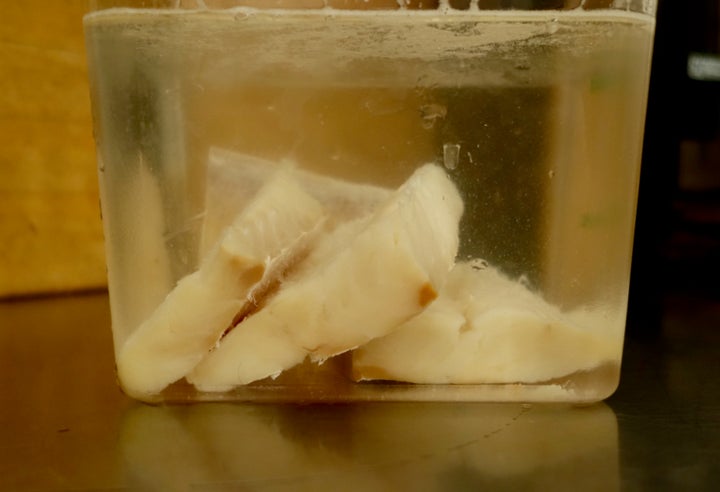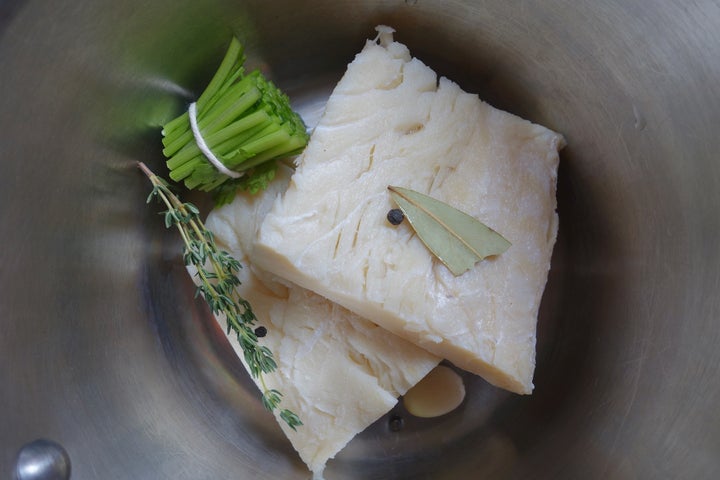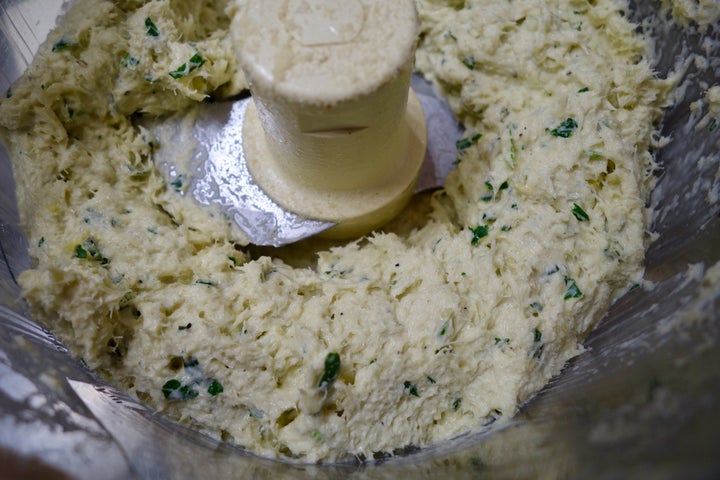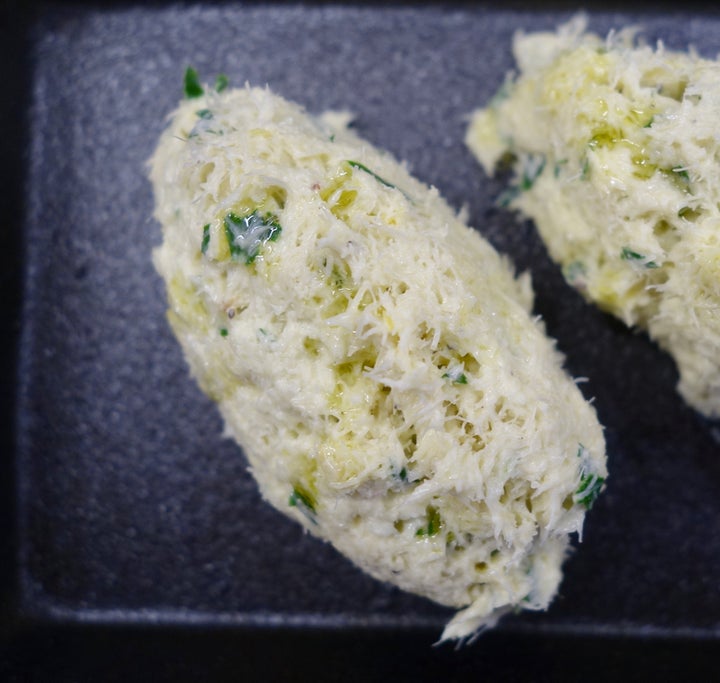In my recent note on our visit to Trieste I mentioned that Jackie and I were served an antipasto of baccalà mantecato: dried cod, reconstituted, cooked and whipped up with seasonings, oil and sometimes a few other things. Presented as a hand-held snack on thin-crusted but crunchy bread or on canapés of grilled or fried polenta, or as a sit-down first course with soft polenta, it has a soft, somewhat fibrous, almost airy consistency and a light flavor of fish, softened with oil and (sometimes) milk and often spiked with garlic and parsley.
A friend of ours with fond family memories of baccalà saw that reference and wondered whether it was feasible to cook such things here in the New World. It is, and since he was joining us for dinner this week I thought I’d prepare not just a version of baccalà mantecato, but also a dish of rigatoni with baccalà based on a fine one we had at Al Covo restaurant in Venice during the same trip. I’ll write about the pasta soon but today will make a start with my batch of whipped codfish.
A note on terminology: Generally speaking, baccalà and similar words refer to cod that has been salted for preservation but which, while dense, remains comparatively supple to the touch – hardly soft, but yielding, like a dry-cured raw ham such as prosciutto. In and around Venice, however, “baccalà” means what everybody else calls stockfish, which is air-dried and stiff as a board when you buy it. For both dishes on our menu, I opted for salt cod, purchased in nice boneless fillets (some salt fish packaged as baccalà or bacalao turns out to be pollack when you read the fine print: not a terrible thing to eat, but you shouldn't have too much trouble finding true cod, which is what you ought to buy).
I soaked the cod – the package weighed one pound (450 g) – for 36 hours in a large container in the refrigerator, changing the water four or five times over that day and a half. Setting aside one piece for the next day’s pasta dish, I placed 12 oz (350 g) of the soaked fish into a saucepan with two peeled cloves of garlic, a few whole black peppercorns, a bundle of parsley stems, a sprig of fresh thyme and half a bay leaf, then added 1-1/2 cups (360 ml) each of cold water and whole milk, which in my pan was enough to just cover the fish – use as much as it takes to make sure the cod is pretty well submerged. I brought it up to the boil, then lowered the heat to a gentle simmer and cooked the fish for 25 minutes partly covered until easily flaked.
I let it grow tepid in the cooking liquid, then transferred the fish to the work bowl of a food processor. You can also use a stand mixer fitted with a flat paddle, but I don’t see the advantage of this apart from its better mimicking the action of the traditional wooden spoon. I added a couple of tablespoonsful of the strained cooking liquid, the two garlic cloves (now soft and mild) and some salt (after its soaking, the fish is anything but salty), and ran the food processor until the cod was reduced to a fibrous mash. Now came the oil: with the machine running, I slowly added about a quarter cup (60 ml) extra virgin olive oil and not quite that much neutral oil. You can use all olive oil, but I find it too assertive.
Now it is a question of tinkering. Salt and pepper needed to be adjusted and more oil beaten in, along with a handful of parsley (you can add whole leaves and let the food processor chop it as it is mixed in), half a raw garlic clove finely grated and the grated zest of half a lemon (a Microplane is the perfect tool for both the garlic and the lemon). At this point I refrigerated it (in the food processor work bowl) and when it was cool I made last-minute flavoring touchups.
You may find the mixture a trifle wet; it will come together in the fridge, but one way to bind the cod is to beat in a couple of tablespoonsful of bread crumbs and give them a few minutes to soak up the moisture. That’s cheating, as is the addition of mashed potato, which isn’t to say that either practice is unknown in Italy or in my house. Now, I transferred it into a bowl, tightly covered it with plastic wrap and put in the refrigerator, all ready for the next night’s aperitifs.
To serve, I removed the mixture from the fridge half an hour before serving, then crisped small squares of cooked polenta in a lightly oiled skillet and topped each with a little mound of baccalà drizzled with a few drops of excellent olive oil and garnished with a few strands of grated lemon zest.
Was it what we ate on the Adriatic coast? No: salt cod yields a different dish than stockfish. But in its own right it made a lovely accompaniment to a negroni or a geographically appropriate glass of prosecco. Recreating dishes eaten on vacation, even imperfectly, is one of the best souvenirs you can bring home.

I soaked the salt cod in plenty of water for around 36 hours

The soaked cod ready to be poached in a mixture of water and milk

In the food processor with a couple of tablespoons of the cooking liquid

With oil, salt, pepper, parsley and lemon zest added

To be served on crunchy bread or, even better, canapés of fried or grilled polenta